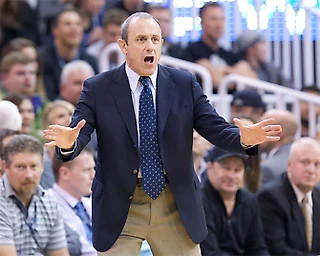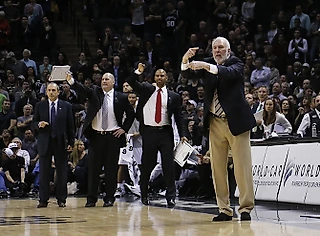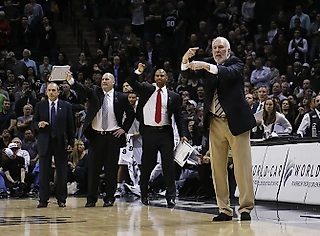Coaching experienced players
Today I’d like to focus on the main aspects of coaching a group of older players.
Many people think coaches or top managers are like chess players, strategists who move wooden pieces. That’s not how I see it. Here’s an example. You cannot make people responsible. You can only try to help them become responsible by giving an example, pressing them or giving them valuable recommendations when they need it. But only players themselves may take those crucial steps to become responsible, to advance to the next level. Players who are not responsible will always need you on the side. That is not what I want in my team.
Many players tend to think that their responsibility is limited to receiving an instruction from coach and trying to follow it the best possible way without being involved in evaluating the result. They feel they are doing well as long as they follow your instruction. It never occurs to them that instruction might be interpreted differently depending on the situation and that they might achieve a much better result by not following it exactly. They think doing everything by coach’s request is a big part of being a player. They don’t understand that all rules or instructions are general.
Let me give you an example. If you are approaching a traffic circle the rule should be to stop, make sure the road is clear and then go. But depending on the situation, your driving experience and a car you have you can speed up a little bit instead, safely go by and thus prevent a traffic jam. You have to evaluate the advantage you can take from a given situation. It’s your responsibility. But players sometimes play like a driver who arrives at a traffic circle and stops no matter what. They cause a traffic jam, even if there is no one they should let go first, only because they respect the rules. That’s a problem.
Following the rules strictly is not an integral part of being a good player. Neither should it be the key part of “coach-player” relationship. At least, it doesn’t work this way for me.
In basketball the same rule applies differently depending on the situation on the court. Let’s say, we have a rule to find an open man to shoot. If I play basketball, to be open I need the defender to be at least 2 meters away from me, because I’m slow and need some space and time. Suppose great players that everybody knows, Kirilenko and Ginobili, are also in my team. They are incredible athletes with great vertical jump. Even if they are guarded, they can either go by an opponent or jump higher so they are as free as I am with 2 meters of distance. According to the rule you might say: Ettore is open, but Kirilenko and Ginobili are defended, so they should pass the ball. However with the great quickness they have, if they make a step or jump they will be as free as I am. And in this case you want them to shoot, not me, because they are much better shooters than me. So, the rule might say the open man takes a shot, but we all must understand what means for each of us to be open in accordance with our different abilities. It cannot be the same for everybody.
If I want to do with my limited abilities what Kirilenko or Ginobili can do, I’ll simply turn the ball over. For them, dribbling against a quick defender who is pressing them probably means to get advantage and do good things for the team. It might look the same only on PlayStation — offensive player trying to go by his man, — not in real life. If one player has more talent than the other, there will be two completely different situations in reality. Let’s not forget: we don’t coach PlayStation, we coach human beings.
If you as a coach apply a rule the same way to everyone, you forget the fact you have different talents among your players and you fail to use it. If the players want the rule applied strictly without accepting that they have different talents, abilities and level of responsibility, you cannot have a team. You have a group of robots.
Now, we get down to the core of the coaching job. The main part of coaching an experienced team is to create different situations during everyday practices to help players understand their different abilities and different ways of interpreting the rule depending on their abilities.
You organize practices, exercises, drills so that your players play against one another in different situations and it starts to be clear what talents you have in the team. Players get to understand who is better in one field and who is better in another.
It’s all about teaching players to understand their abilities and use them the best possible way.
Another great part of the coaching job is defining which couples of players or groups of three or four players interact better. Sometimes you think “these 5 players are my best combination”. But these 5 players might be not the best match. They just don’t click together. You just take away one and put another one (even if he’s not as good) and everything starts to work. It’s like Rubik’s cube.




